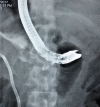Successful ERCP for management of traumatic pancreatic disruption in a patient with situs inversus
- PMID: 29552451
- PMCID: PMC5849630
- DOI: 10.5582/irdr.2017.01072
Successful ERCP for management of traumatic pancreatic disruption in a patient with situs inversus
Abstract
Endoscopic retrograde cholangio-pancreatography (ERCP) is an important tool for treatment of pancreaticobiliary diseases. However, ERCP may be difficult in patients who have altered gastrointestinal anatomy due to congenital or surgical reasons. A 40-year-old male with HIV infection presented with abdominal pain following abdominal trauma. The patient was diagnosed to have traumatic pancreatic injury and underlying situs inversus. The pancreatic fluid collection was drained using radiology guided pigtail placement done for the symptoms of abdominal pain and vomiting. The resulting external pancreatic fistula was successfully managed with ERCP and stenting. The patient improved with disappearance of ascites and resolution of pigtail output which was then removed. We report the technique used for ERCP in this patient. We also review the literature on pancreatic endotherapy in patients with situs inversus. The published literature suggests that with modifications in the standard ERCP technique like mirror image technique, 180 degree turn technique, left lateral technique etc. these patients can be managed successfully.
Keywords: ERCP; Pancreatic trauma; endoscopy; fistula; pancreatic stent; situs inversus.
Figures
Similar articles
-
Successful endoscopic drainage of malignant obstructive jaundice in patients with situs inversus totalis: Two cases report.Int J Surg Case Rep. 2022 Apr;93:106873. doi: 10.1016/j.ijscr.2022.106873. Epub 2022 Feb 25. Int J Surg Case Rep. 2022. PMID: 35290847 Free PMC article.
-
[Posttraumatic pancreatic fistula: successful endoscopic stent placement].Presse Med. 2006 Dec;35(12 Pt 1):1831-4. doi: 10.1016/s0755-4982(06)74910-7. Presse Med. 2006. PMID: 17159736 French.
-
Successful access to the ampulla for endoscopic retrograde cholangiopancreatography in patients with situs inversus totalis: a case report.BMC Surg. 2017 Nov 28;17(1):112. doi: 10.1186/s12893-017-0307-x. BMC Surg. 2017. PMID: 29183311 Free PMC article.
-
[Surgical treatment of choledocholithiasis in a patient with situs inversus totalis: a case report and literature review].Medwave. 2017 Jul 26;17(6):e7002. doi: 10.5867/medwave.2017.06.7002. Medwave. 2017. PMID: 28820866 Review. Spanish.
-
Therapeutic endoscopic retrograde cholangiopancreatography in a patient with situs inversus viscerum.World J Gastroenterol. 2015 May 14;21(18):5744-8. doi: 10.3748/wjg.v21.i18.5744. World J Gastroenterol. 2015. PMID: 25987802 Free PMC article. Review.
Cited by
-
Successful endoscopic retrograde cholangiopancreatography using pancreatic guidewire placement for biliary cannulation in a patient with situs inversus and Billroth-I gastrectomy (with video).JGH Open. 2019 Feb 20;3(6):540-541. doi: 10.1002/jgh3.12163. eCollection 2019 Dec. JGH Open. 2019. PMID: 31832558 Free PMC article.
-
Double rarity: malignant masquerade biliary stricture in a situs inversus totalis patient.BMC Surg. 2021 Mar 21;21(1):153. doi: 10.1186/s12893-021-01155-w. BMC Surg. 2021. PMID: 33743673 Free PMC article.
References
-
- Claydon M, McLaughlin S. Gastrointestinal: Situs inversus viscerum. J Gastroenterol Hepatol. 2002; 17:1329. - PubMed
-
- Téllez-Ávila FI, Pattel S, Duarte-Medrano G, Seenath M, Herrera-Mora DR, Lopez-Arce G. A challenging case of giant biliary stones in a patient with situs inversus totalis: Conventional ERCP combined with intraductal cholangioscopy and laser lithotripsy. Endoscopy. 2017; 49:E248-E249. - PubMed
-
- Morales-Rodríguez JF, Corina Cotillo E, Moreno-Loaiza O. Surgical treatment of choledocholithiasis in a patient with situs inversus totalis: A case report and literature review. Medwave. 2017;17:e7002. (in Spanish) - PubMed
-
- Chowdhury A, Chatterjee BK, Das U, Dutta P, Dhali GK, Banerjee PK. ERCP in situs inversus: Do we need to turn the other way? Indian J Gastroenterol. 1997; 16:155-156. - PubMed
Publication types
LinkOut - more resources
Full Text Sources
Other Literature Sources



